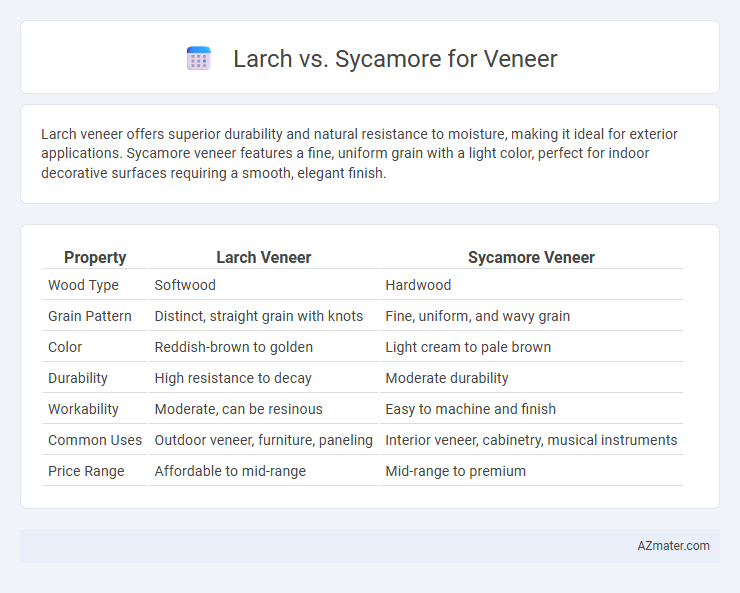Larch veneer offers superior durability and natural resistance to moisture, making it ideal for exterior applications. Sycamore veneer features a fine, uniform grain with a light color, perfect for indoor decorative surfaces requiring a smooth, elegant finish.
Table of Comparison
| Property | Larch Veneer | Sycamore Veneer |
|---|---|---|
| Wood Type | Softwood | Hardwood |
| Grain Pattern | Distinct, straight grain with knots | Fine, uniform, and wavy grain |
| Color | Reddish-brown to golden | Light cream to pale brown |
| Durability | High resistance to decay | Moderate durability |
| Workability | Moderate, can be resinous | Easy to machine and finish |
| Common Uses | Outdoor veneer, furniture, paneling | Interior veneer, cabinetry, musical instruments |
| Price Range | Affordable to mid-range | Mid-range to premium |
Introduction to Larch and Sycamore Veneer
Larch veneer, valued for its durability and rich reddish-brown hues with prominent grain patterns, is often used in furniture and interior paneling for a warm, rustic aesthetic. Sycamore veneer, known for its light, creamy color and fine, consistent grain, offers a smooth, elegant finish ideal for modern cabinetry and decorative applications. Both veneers provide unique textures and strength properties, making them versatile choices depending on design preference and functional requirements.
Botanical Overview: Larch vs Sycamore
Larch (genus Larix) is a deciduous conifer known for its needle-like leaves and durability, commonly sourced from species like Larix decidua and Larix kaempferi, making it ideal for veneer with a fine, straight grain and warm, reddish tones. Sycamore (Acer pseudoplatanus), a deciduous hardwood in the maple family, features broad leaves and a creamy-white to light brown color with subtle grain patterns, prized for its smooth texture and uniform appearance in veneer applications. Both species offer unique structural and aesthetic qualities, with larch providing strength and resilience, while sycamore delivers a refined, visually appealing surface.
Appearance and Grain Characteristics
Larch veneer features a warm reddish-brown hue with prominent, straight grain patterns that offer a rustic and textured aesthetic ideal for natural-themed interiors. Sycamore veneer displays a lighter, creamy to pale brown color with subtle, fine grain and occasional wavy or curly figures, providing a smooth and elegant appearance suitable for modern and refined designs. The contrasting grain consistency between Larch's pronounced lines and Sycamore's delicate, flowing patterns makes each wood distinct in enhancing veneer projects based on desired visual impact.
Color Variations in Larch and Sycamore Veneers
Larch veneer showcases a rich range of warm tones, from golden honey to deep reddish-brown, often featuring striking grain patterns and resin canals that add natural texture. Sycamore veneer is known for its lighter, creamy hues, exhibiting subtle variations from pale beige to soft pink, with a delicate and uniform grain structure. The color variations in larch veneers tend to be more pronounced and vibrant, while sycamore veneers offer a consistent, elegant palette ideal for bright, contemporary interiors.
Durability and Strength Comparison
Larch veneer offers exceptional durability and moisture resistance, making it ideal for applications exposed to varying humidity and outdoor conditions. Sycamore veneer provides moderate strength with a fine, uniform texture, but it is less resistant to wear and moisture compared to Larch. When prioritizing longevity and robustness, Larch outperforms Sycamore in structural stability and lifespan.
Workability and Machining Differences
Larch veneer features a dense, resinous structure that can challenge machining with increased tool wear and requires slower feed rates for clean cuts, whereas sycamore veneer offers a fine, uniform grain that enhances workability and allows smoother, faster machining with less tool strain. Larch's hardness and natural oils demand sharp blades and slower cutting speeds to prevent surface tearing, while sycamore's softer texture facilitates precise shaping and sanding with minimal effort. Choosing between larch and sycamore veneers depends on balancing durability needs against ease of handling during veneer application and finishing processes.
Common Applications in Veneer Projects
Larch veneer is prized for its durability and warm, reddish tones, making it ideal for furniture, wall paneling, and cabinetry where a rustic or natural aesthetic is desired. Sycamore veneer, with its fine, uniform texture and light color, is commonly used in high-end furniture, musical instruments, and decorative veneers that require a smooth, elegant finish. Both species offer versatility, but Larch suits outdoor or heavy-use applications due to its toughness, whereas Sycamore excels in detailed craftsmanship and interior decorative elements.
Cost and Availability Factors
Larch veneer offers a moderate cost with good durability, commonly sourced from Siberian and European larch species, making it relatively accessible in northern markets. Sycamore veneer tends to be pricier due to its finer grain and lighter color, primarily harvested in North America and parts of Europe, which can limit availability depending on the region. Both veneers vary in availability based on seasonality and logging regulations, impacting overall procurement costs for large-scale projects.
Environmental Impact and Sustainability
Larch veneer offers high durability with natural resistance to decay, making it a sustainable option that reduces the need for chemical treatments and extends product lifespan. Sycamore veneer, sourced from fast-growing hardwoods, supports reforestation efforts and carbon sequestration but typically requires more energy in processing due to its denser grain structure. Choosing larch or sycamore veneer depends on eco-conscious priorities, where larch emphasizes longevity and low chemical impact, while sycamore focuses on renewable growth and carbon footprint reduction.
Conclusion: Choosing the Right Veneer
Larch veneer offers exceptional durability and a distinct reddish hue, making it ideal for rustic and outdoor-inspired interiors, while sycamore veneer provides a smooth, pale finish well-suited for modern and minimalist designs. The choice between larch and sycamore ultimately depends on the desired aesthetic and environmental conditions, with larch excelling in moisture resistance and sycamore favored for its fine grain and uniform appearance. Selecting the right veneer should balance visual appeal with practical performance to ensure lasting beauty and functionality.

Infographic: Larch vs Sycamore for Veneer
 azmater.com
azmater.com